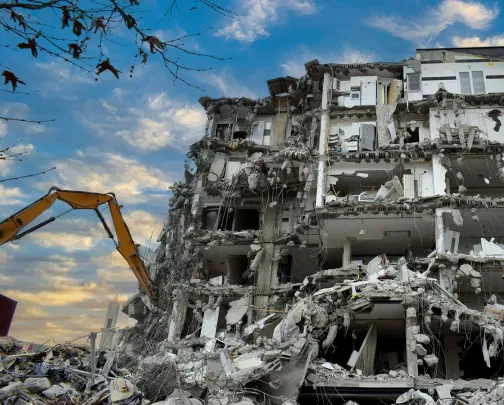Seismic risks in Turkey and Greece post 2025 earthquakes
In the wake of the April and May 2025 earthquakes in Turkey and Greece, Howden Re’s Head of International Catastrophe Model Research provides insights on the industry’s approach to supporting communities and mitigating risk in the region
The context
Two earthquakes in short succession - first in Istanbul on 23 April, and most recently off the coast of Crete on 14 May - have highlighted the continued seismic volatility of the Eastern Mediterranean. While these events occurred on separate fault lines and are not connected to each other, they both stem from the same broader tectonic dynamics that make the region one of Europe’s most earthquake prone.
The April event, which was centered on the extension of the North Anatolian Fault beneath the Sea of Marmara, caused ground shaking which remained within design standards for Istanbul. As a result, the frequency content of the motion was not especially damaging to the city’s mid- to high-rise buildings and only caused a limited number of injuries. However, the event highlighted the city’s vulnerability to a 7+ magnitude earthquake, with the impact predicted to be significantly more severe in such a case.
The more recent earthquake near the islands of Karpathos and Crete, a magnitude 6.0 quake in the early hours of 14 May, occurred offshore and at considerable depth, estimated between 60 and 74 kilometres. These factors helped to limit its impact, despite the tremor being felt as far away as Egypt.

While it remains impossible to predict when and where a major earthquake will strike, the geological reality is that Istanbul, in particular, remains vulnerable. The last major rupture along the central Marmara Sea segment of the North Anatolian Fault most likely occurred in 1766. A comparable event today could result in ground motions up to 60 times stronger than the April 2025 quake. A mid-7 magnitude rupture at the central-eastern Marmara Sea section would also be more likely to propagate eastward towards Istanbul, which would then result in stronger ground motion there and thus a higher seismic risk.
Earthquake preparedness and resilience initiatives in the region
Regional advances in earthquake preparedness and catastrophe modelling, alongside sustained investments in infrastructure, emergency response capacity, and public awareness, continue to change the potential impact of seismic activity. However, in Istanbul, while the city has demonstrated notable resilience, older building stock and population density could hamper recovery. Building more supportive infrastructure in high-risk areas, such as Gungoren, G. Osmanpasa, and Esenler will be critical. One such major initiative, the Istanbul Seismic Risk Mitigation and Emergency Preparedness Project, run by the Asian Infrastructure Investment Bank, aims to strengthen public buildings like schools and hospitals against earthquakes and improve disaster response capabilities. The project, with a budget of USD 300 million, also aims at establishing emergency communication systems, raising public awareness, and training programmes to improve household and institutional preparedness, and indirectly supporting economic stability in Istanbul.
ISMEP has been highly successful in achieving significant reductions in vulnerability to earthquakes in Istanbul. The project has attracted substantial additional financing from international financial institutions, enabling it to scale up its efforts. Key factors contributing to its success include a sub-national, multi-sectoral approach, a strong project coordination unit, and effective stakeholder engagement. However, challenges remain in replicating the model elsewhere in Turkey due to financing constraints and limited government ownership.

The role of insurance in earthquake resilience
Insurance undoubtedly plays a crucial factor in an earthquake’s aftermath. For example, when the magnitude 7.6 and 7.8 earthquakes hit Kahramanmaraş, the Turkish Catastrophe Insurance Pool (TCIP) was able to respond quickly, proactively launching USD 533 million of advance payments, as a high proportion of the region was covered by the compulsory insurance scheme instigated following the 1999 Kocaeli and Duzce earthquakes. In the weeks after, the total property damage covered by the insurance industry would reach USD 6.2 billion, a nonetheless small proportion of the total economic losses.
While the residential compulsory insurance penetration rate in Turkey is 57.5%, with the Marmara region reaching the highest rates at 65.5%, a large protection gap still exists. Traditional insurance products, as well as parametric solutions, can help further alleviate the financial burden of future events across the society. Similarly to Turkey, Greece is now also establishing its first compulsory natural catastrophe insurance schemes, with coverage for motor and businesses with turnover of more than EUR 500,000 mandated as of next month.
However, the role of the insurance industry can be much wider than simply responding to indemnify those affected. By leveraging historical data on losses and damage patterns, insurers can improve risk assessments and assist the engineering community design safer infrastructure. Financial incentives, like we see in the UK and other countries, encourage earthquake-resistant construction, fostering a culture of preparedness. Successful public education campaigns have spread awareness, equipping individuals with effective preparedness strategies. A united, ongoing commitment among stakeholders is essential to reducing the devastating impact of earthquakes.
Dr. Myrto Papaspiliou commented: “The events of April and May 2025 are timely reminders of the ever-present seismic risks across the Eastern Mediterranean. While recent earthquakes have caused limited damage, the next major rupture may not be as forgiving. Strengthening preparedness and accelerating resilience investments, particularly in urban centres like Istanbul, will be essential to protecting lives, assets, and economic continuity. The insurance sector has a pivotal role to play in bridging protection gaps, deploying advanced modelling tools, and informing smarter risk mitigation across the region.”